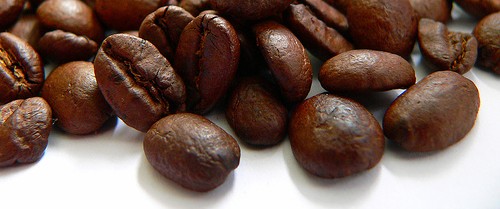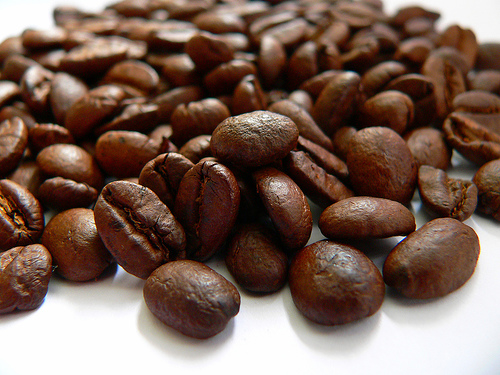Caffeine Occurrence

Cas No. [58-08-2]
Roasted coffee beans, a common source of caffeine
Caffeine is found in many plant species, where it acts as a natural
pesticide, with high caffeine levels being reported in seedlings
that are still developing foliages, but are lacking mechanical
protection; caffeine paralyzes and kills certain insects feeding
upon the plant. High caffeine levels have also been found in the
surrounding soil of coffee bean seedlings. It is therefore
understood that caffeine has a natural function as both a natural
pesticide and as an inhibitor of seed germination of other nearby
coffee seedlings thus giving it a better chance of survival.
 The most commonly used sources of caffeine are coffee, tea, and to a
lesser extent The most commonly used sources of caffeine are coffee, tea, and to a
lesser extent cacao. Less commonly used sources of caffeine include
the yerba maté and guarana plants,which are sometimes used in the
preparation of teas and energy drinks. Two of caffeine's alternative
names, mateine and guaranine, are derived from the names of these
plants. Some yerba mate enthusiasts assert that mateine is a
stereoisomer of caffeine, which would make it a different substance
altogether. This is not true because caffeine is an achiral
molecule, and therefore has no enantiomers; nor does it have other
stereoisomers. The disparity in experience and effects between the
various natural caffeine sources could be due to the fact that plant
sources of caffeine also contain widely varying mixtures of other
xanthine alkaloids, including the cardiac stimulants theophylline
and theobromine and other substances such as polyphenols which can
form insoluble complexes with caffeine. cacao. Less commonly used sources of caffeine include
the yerba maté and guarana plants,which are sometimes used in the
preparation of teas and energy drinks. Two of caffeine's alternative
names, mateine and guaranine, are derived from the names of these
plants. Some yerba mate enthusiasts assert that mateine is a
stereoisomer of caffeine, which would make it a different substance
altogether. This is not true because caffeine is an achiral
molecule, and therefore has no enantiomers; nor does it have other
stereoisomers. The disparity in experience and effects between the
various natural caffeine sources could be due to the fact that plant
sources of caffeine also contain widely varying mixtures of other
xanthine alkaloids, including the cardiac stimulants theophylline
and theobromine and other substances such as polyphenols which can
form insoluble complexes with caffeine.
One of the world's primary sources of caffeine is the coffee "bean"
(which is the seed of the coffee plant), from which coffee is
brewed. Caffeine content in coffee varies widely depending on the
type of coffee bean and the method of preparation used; even beans
within a given bush can show variations in concentration. In
general, one serving of coffee ranges from 40 milligrams, for a
single shot (30 milliliters) of arabica-variety espresso, to about
100 milligrams for a cup (120 milliliters) of drip coffee.
Generally, dark-roast coffee has less caffeine than lighter roasts
because the roasting process reduces the bean's caffeine content.
Arabica coffee normally contains less caffeine than the robusta
variety. Coffee also contains trace amounts of theophylline, but no
theobromine.
Tea is another common source of caffeine. Although tea contains more
caffeine than coffee, a typical serving contains much less, as tea
is normally brewed much weaker. Besides strength of the brew,
growing conditions, processing techniques and other variables also
affect caffeine content. Certain types of tea may contain somewhat
more caffeine than other teas. Tea contains small amounts of
theobromine and slightly higher levels of theophylline than coffee.
Preparation and many other factors have a significant impact on tea,
and color is a very poor indicator of caffeine content. Teas like
the pale Japanese green tea gyokuro, for example, contain far more
caffeine than much darker teas like lapsang souchong, which has very
little.
Caffeine is also a common ingredient of soft drinks such as cola,
originally prepared from kola nuts. Soft drinks typically contain
about 10 to 50 milligrams of caffeine per serving. By contrast,
energy drinks such as Red Bull can start at 80 milligrams of
caffeine per serving. The caffeine in these drinks either originates
from the ingredients used or is an additive derived from the product
of decaffeination or from chemical synthesis. Guarana, a prime
ingredient of energy drinks, contains large amounts of caffeine with
small amounts of theobromine and theophylline in a naturally
occurring slow-release excipient.
Chocolate derived from cocoa contains a small amount of caffeine.
The weak stimulant effect of chocolate may be due to a combination
of theobromine and theophylline as well as caffeine.A typical
28-gram serving of a milk chocolate bar has about as much caffeine
as a cup of decaffeinated coffee.
In recent years various manufacturers have begun putting caffeine
into shower products such as shampoo and soap, claiming that
caffeine can be absorbed through the skin.However, the effectiveness
of such products has not been proven, and they are likely to have
little stimulatory effect on the central nervous system because
caffeine is not readily absorbed through the skin.
Various manufacturers market caffeine tablets, claiming that using
caffeine of pharmaceutical quality improves mental alertness. These
effects have been borne out by research that shows that caffeine use
(whether in tablet form or not) results in decreased fatigue and
increased attentiveness. These tablets are commonly used by students
studying for their exams and by people who work or drive for long
hours.
Caffeine is also used pharmacologically to treat apnoea in premature
newborns and as such is one of the 10 drugs most commonly given in
neonatal intensive care, though questions are now raised based on
experimental animal research whether it might have subtle harmful
side-effects.

>>
New Product
Introduced :
Oseltamivir
Phosphate,
Phenyl Propanolamine,
Phenylephrine,
Etafedrine

|

 We all know that one of the most
powerful chemical compounds found in both coffee and tea is
caffeine. Has caffeine become an important part of your daily life?
Did you know We all know that one of the most
powerful chemical compounds found in both coffee and tea is
caffeine. Has caffeine become an important part of your daily life?
Did you know
Article : What Is Caffeine?
 Caffeine is a drug that is naturally
produced in the leaves and seeds of many plants. It's also produced
artificially and added to certain foods. Caffeine is defined as a
drug because it stimulates the central nervous system, causing
increased alertness. Caffeine gives most people a temporary energy
boost and elevates mood. Caffeine is a drug that is naturally
produced in the leaves and seeds of many plants. It's also produced
artificially and added to certain foods. Caffeine is defined as a
drug because it stimulates the central nervous system, causing
increased alertness. Caffeine gives most people a temporary energy
boost and elevates mood.
Caffeine is in tea, coffee, chocolate, many soft drinks, and pain
relievers and other over-the-counter medications. In its natural
form, caffeine tastes very bitter. But most caffeinated drinks have
gone through enough processing to camouflage the bitter taste.
Teens usually get most of their caffeine from soft drinks and energy
drinks. (In addition to caffeine, these also can have added sugar
and artificial flavors.) Caffeine is not stored in the body, but you
may feel its effects for up to 6 hours.
![Caffeine Cas No. [58-08-2]](caffeine/CAFFEINE%20LOGO%20SMALL.bmp)
|


